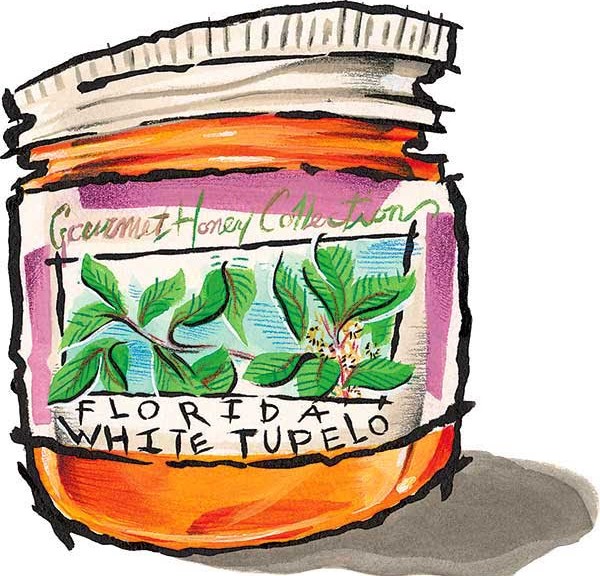Right now, somewhere in northern Florida, I bet there are a bunch of trucks filled with bees headed to the Apalachicola river. In the next couple of weeks ogeechee tupelo trees will erupt in blossom along those river banks. It’s not a showy blossom, like the cherry trees that will soon bloom here in Michigan. Ogeechee flowers are greenish yellow and blend in with the leaves, so there’s not much to see. Ogeechee trees are also partial to growing in really wet spots, like swamps, so even if you wanted to go try to see the blossoms they’re not easy to get to. But the nectar from ogeechee blossoms is used to make tupelo honey. So every year beekeepers bring in hives—first by truck, then by boat—and set them up in the swamps to make honey while the trees bloom.
Most professional beekeepers only make honey as an afterthought.
Their primary job is providing pollination services to farmers. 85% of the crops in the US are pollinated by bees. Standard practice is to truck hives around from farm to farm as each new crop blossoms. Most of the honey that the bees produce is sold off to bulk producers who blend it with all the other honey they get, pasteurize it, and then sell a fairly consistent—if not all that interesting—honey, like the stuff in those classic plastic bears.
However, with a little more care and effort, a beekeeper can produce a varietal honey—that is, a honey made from the nectar of only a single type of flower. Getting the bees to use only a single type of flower relies on a certain amount of luck. Left to their own devices, bees will go for a convenient source of nectar. There’s no way to tell them that you want them to go for only a particular flower. Bringing the hives to orchards or fields growing a single product at the precise time those flowers are blooming is a good way to encourage the bees to use just one type of flower, but there may be wildflowers blooming nearby, or weather patterns may result in crops that usually bloom at different times being in blossom all at once.
Having a mix of different nectars isn’t necessarily a bad thing. There are some fantastic wildflower honeys out there that are made from dozens of different flowers. But just like different grapes produce wines with different qualities, different nectars produce honeys with different qualities. Varietal honeys can be as different as sauvignon blanc and merlot, ranging from sweet to bitter, from thin liquids to grainy pastes, from light and ethereal to rich and earthy.
No one pays beekeepers to pollinate ogeechee trees.
Ogeechee trees do produce a tart fruit called an ogeechee lime, but they’re not grown commercially. (Imagine tending an orchard in a swamp!) Since no one pays for pollination, the beekeepers who haul their hives out into the swamps do it purely to produce the honey. Once the hives are in place, it’s a gamble to see how much honey will be produced and how good it will be. At best, the flowers only bloom for a few weeks, but some years there’s only enough nectar to make honey for a few days. If it’s too rainy during that time then the bees won’t leave the hive, so they don’t make honey at all. If there are other flowers blossoming nearby at the same time and the bees use a mix of nectars, the honey will most likely crystallize and the flavor won’t be quite as exceptional.
Part of what makes tupelo honey so prized is that it almost never crystallizes. Most honeys that aren’t pasteurized will eventually go from being liquid to being much more solid as the sugars crystallize. Whether or not the honey crystallizes has to do with the sugar composition. Honey is made of a mix of fructose and glucose. The ratio of the two sugars depends on the sugars in the nectars used to make the honey. Honeys with more glucose are quicker to crystallize. Honeys higher in fructose are more likely to remain in a liquid state. Think glue for glucose, flow for fructose for a quick mnemonic. Most honeys have enough glucose that, over weeks or months, the honey will crystallize. (If it does, heating it in a water bath will bring it back to a flowing liquid.) Ogeechee nectar has so much fructose that pure tupelo honey does not crystallize.
But it’s the flavor of tupelo honey that really gets people going. It has a caramelly sweet aroma and a light, floral flavor that lasts and lasts. It’s quite sweet—when Van Morrison said “She’s as sweet as tupelo honey,” he must have been talking about someone very sweet indeed. There’s a bright note on the finish that reminds me a bit of the cooling effects of menthol. I think of it as a platonic ideal of honey—sweet but not cloying, flowy, bright, and really, really pleasant. An excellent addition to tea, biscuits, scones, oatmeal, toast, goat cheese, or hot toddies.

